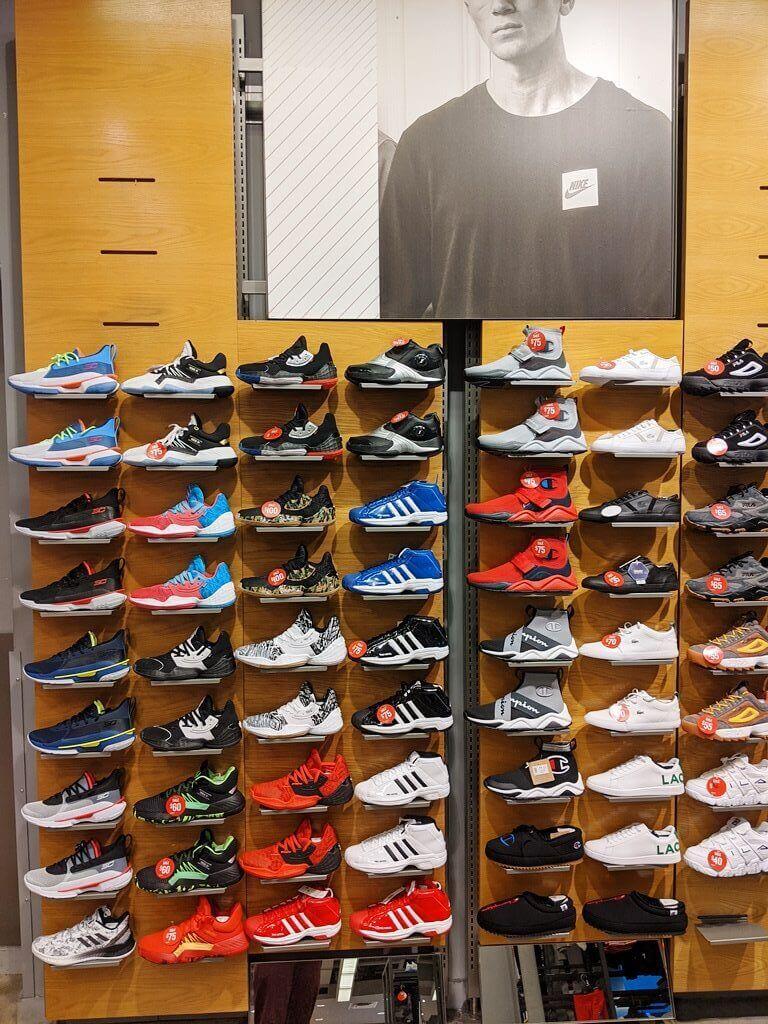![]()
The question that was posed in several stores was, “Do you think the way the sneakers are presented in the store contribute to the ability to sell the footwear?”
In one store the most recent releases are presented inside of display cases like jewelry. In other stores the shoes are placed on tables by brand and they funnel to apparel and sneaker walls around the stores. There really isn’t any other way to display footwear. When there are over 500 styles readily available the only way to present the footwear is the most efficient method, rows and rows of sneakers. In order to get the employees to engage in the back and forth I had to utilize a Socratic approach. I led with questions and responded with questions. A few of the details that were raised actually led to answers and a very insightful discussion.
Answers:
- It doesn’t matter how the shoes are presented most people know what they want.
- You can put the sneakers wherever you want and if you don’t have the right pair people aren’t buying.
- We don’t really sell as much as we wait for people to stop Facetiming or talking on the phone.
- People automatically look at Nike first unless they know they want a specific brand.
- Chris, how do we get people to buy the other shoes since we aren’t getting the best releases?
That last answer/question placed the burden on me.
If Nike and adidas aren’t going to send stores a thousand pairs of the hottest shoes and customers are buying online and customers are visiting Nike Outlet stores and Factory Stores, how does a store recapture sales and customers? One manager in another store explained that the layout of her store is predetermined. She has to follow plans. She also stated that this leads to a lack of freshness in the store. The store looks the same whenever customers return to the mall. I asked her if she can change the store whenever she likes. She responded that she has to stick with the plans she’s given. The store with the sneaker wall in the picture stated that most of the people who are on the floor don’t know who the signature shoes belong to. They don’t really have the information needed to sell someone on the right shoe.
While stores all have merchandising plans, the reality is the stores are cluttered and have far too much inventory. This leads to a confusing shopping experience. It also contributes to lost sales because there are too many options available and new shoes sit right next to sale shoes of the exact same model.
Zoom in on the sneaker wall picture and you’ll find a Harden Volume 4 Cookies and Creme at full price while the Barber Shop is on sale. Same with the D.O.N. These shoes are all displayed next to an entire row of Fila that are marked down, but that isn’t the thing that is most difficult for sales leads. The sales lead and the manager are contending with the person who is on their phone. That last answer/question was how do we get the customer to try something else? This first in-store visit post will end with an answer that places the burden squarely where it belongs, on the brand. The easiest way to inspire shopping is for the brand to deliver stories with every style (or the store needs to become just as interactive as the phone via a Perch or the store needs to generate their own in store QR Codes). The QR Code or a simple display card for the Curry 7 from Under Armour should arrive with the model and be placed near the shoes. The sales lead doesn’t have to disrupt the person shopping with questions that take them away from their phones. They only have to say, “You can use your phone to scan the Curry 7 QR Code and it will give you information on performance and design aspects.”
A few years ago Foot Locker introduced a code that could be scanned to learn more about the player behind the signature shoe. It was a project ahead of its time. That system is no longer in the store. During the conversations at the stores there were a number of things that were implemented years ago, that would help today. Those will be covered in the next part of this analysis.
The customer has to be met where they are. The customer is already on the phone so the sales strategy has to account for this and allow the person shopping to engage in this way. Foot Locker removed that system before it got started. That system is the foundation of my answer, which would take far too long for me to write about so instead I’ll revert to the Socratic Method and leave you with a an answer that’s a question. Sneaker stores should be more interactive utilizing the item that takes away the ability of the sales lead and managers to engage the consumer. What is the most cost effective method of implementing features that allow the customer to learn about the product and can stimulate dialogue between the sales person and visitor?
Next topic: Sneaker Stores Gave Women Customers Away to Lululemon


